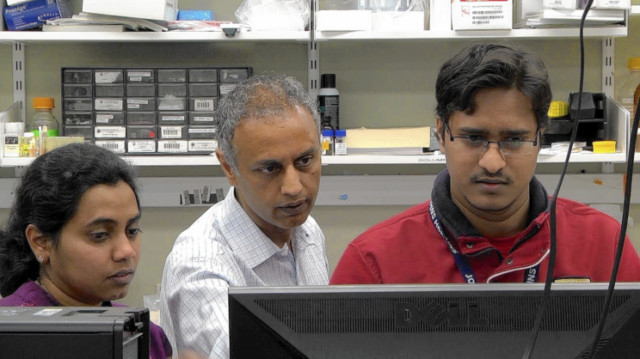
More than a decade has passed since scientists completed the Human Genome Project, a worldwide effort to decode our DNA. That DNA sequence contains instructions for making all of the proteins that our bodies need to function.
Now researchers have catalogued the vast majority of those proteins, creating a dynamic map of the human body called “the proteome.”
The findings, described in a pair of studies published this week in the journal “Nature”, identify the proteins encoded in roughly 17,000 to 18,000 of the estimated 21,000 human genes — including some proteins made by bits of DNA that were once considered “junk.”
These rough drafts of a protein map, which are publicly available online, could help scientists better understand how the body is supposed to work.
“It’s a remarkable achievement,” said Michael Washburn, a proteomics scientist at Stowers Institute for Medical Research in Kansas City, who was not involved in the research.
If DNA carries the blueprint for life, then proteins are the construction workers responsible for putting those plans into action. Built from strings of amino acids, they hustle around the body transporting molecules, facilitating chemical reactions, making repairs and carrying out a vast array of essential tasks around the body.
Haemoglobin, for instance, delivers oxygenated blood to tissues throughout the body. Insulin regulates how our body metabolises carbohydrates and fats. Antibodies allow the immune system to attack intruding bacteria and viruses.
“If it weren’t for proteins, there would be no life,” Washburn said.
That is why researchers set out to build a near-complete list of all the members in the humans protein library.
But they knew that mapping the proteome would be much more complicated than mapping the genome.
For one thing, reading the instructions held in DNA doesn’t necessarily tell you what the protein’s properties will be, because the amino acids can interact in extremely complex ways.
For another, while a complete set of DNA can be found in every cell in the body, different proteins pop up in different abundances in different places. That is why neurons in the brain look and act very different from hepatocytes in the liver and the cardiomyocytes that make up heart muscle.
So both teams of researchers — one based in Germany, the other made up of scientists from America and India — collected tissues from a variety of different sources. Between them, they analysed proteins from blood, ovary, kidney, brain, heart and liver cells. They also looked at proteins found in foetal tissue and proteins extracted from cancer cells.
They chemically snipped the long, complex proteins into smaller units called peptides. Then they analysed the amino acids within the peptides using an instrument called a mass spectrometer.
Altogether, the team led by Akhilesh Pandey, a molecular biologist at Johns Hopkins University in Baltimore, found proteins made by about 84 per cent of the known protein-coding genes. The other team, led by proteomics scientist Bernhard Kuster of the Technical University of Munich, found 92 per cent.
Because the two teams went about their work in slightly different ways, the researchers expect that the overall protein count will rise when they compare their data sets.
Both sets of searchers found a handful of proteins that matched up to regions of DNA that weren’t thought to include protein-coding genes. (Many such regions used to be thought of as “junk DNA,” but that idea has fallen out of fashion.)
“They are genes that have been overlooked,” Kuster said. “That was very surprising.”
Pandey said the new maps would help scientists identify patterns in the body — and perhaps, down the line, allow doctors to identify damaged tissues based on the proteins sloughing off them and washing into the bloodstream. Such a map might even help doctors come up with the best treatment for a cancer based on its particular protein profile.
But to understand these biomarkers of disease or damage, researchers first will have to understand the protein makeup of a healthy person.
Although it may seem like very little of the proteome remains to be sequenced, that is far from the case, researchers said.
The proteome map is far from static — in fact, it’s more like a dynamic heat map that must keep up with changing conditions, Pandey said. When we eat or exercise, for example, our bodies respond by producing different combinations of proteins.
This means it will be a long time before researchers fully understand the human proteome, Pandey added.
“Basically, the proteome will never be done,” he said.
–Los Angeles Times












